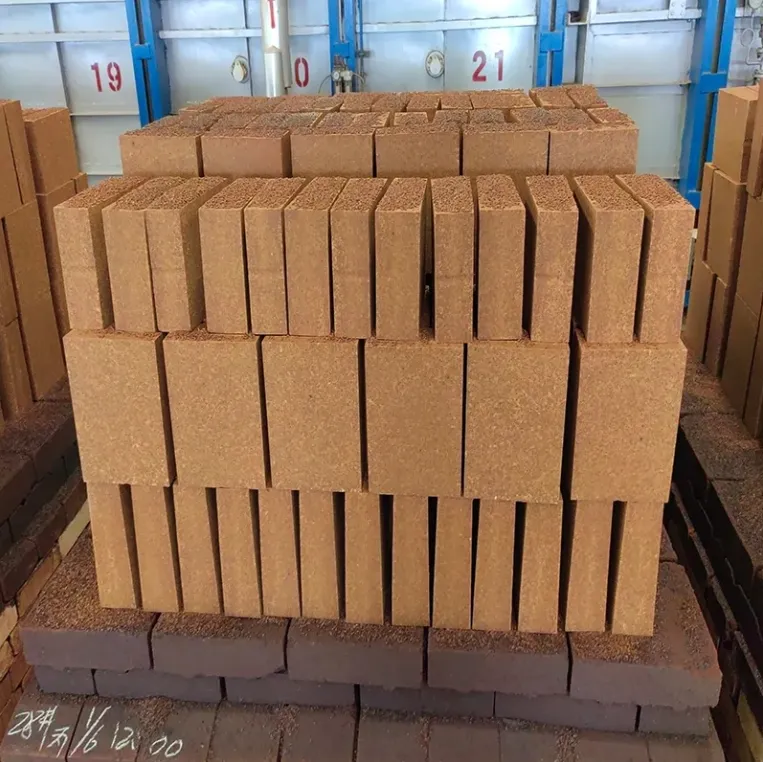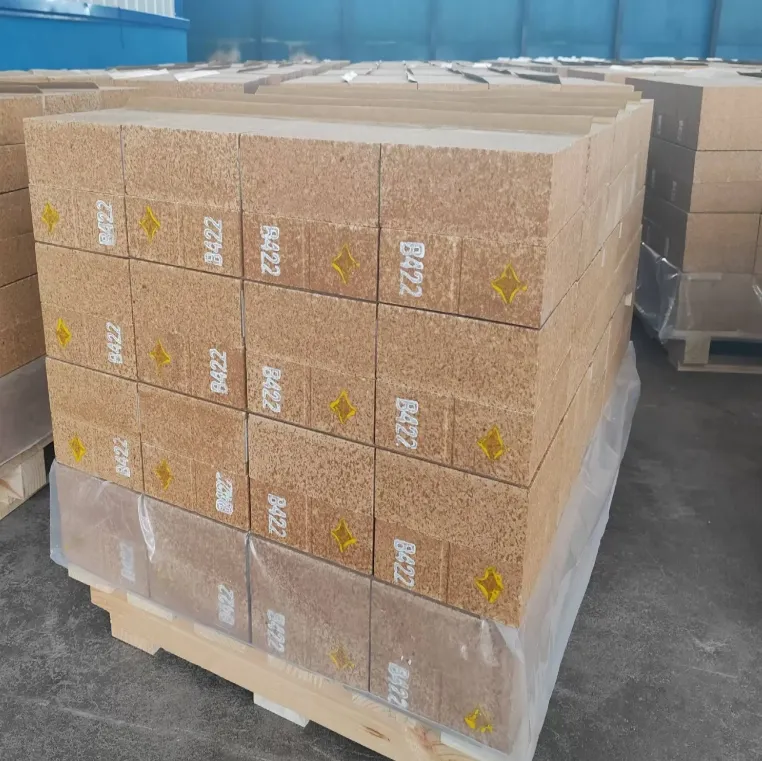High alumina poly light bricks are specialized refractory materials designed for a range of high-temperature industrial applications. These bricks are known for their lightweight and insulating properties, making them an excellent choice for industries that require thermal efficiency and heat resistance without the heavy load of standard refractory bricks. This article will explore the core uses of high alumina poly light bricks, their supporting performance characteristics, and how Highland Refractory products stand out in meeting these demands.
Highland Refractory’s high alumina poly light bricks are lightweight insulating bricks with Al₂O₃ content ranging from 48% to 70% and a bulk density of ≤1.2g/cm³. Unlike standard high alumina bricks, which are designed primarily for high-load and extreme-temperature resistance, poly light bricks are optimized for thermal insulation and reduced weight, making them ideal for low-load or insulation applications. These bricks combine low thermal conductivity, high refractoriness, and thermal shock resistance to provide superior heat management without the added weight.
The core features that make high alumina poly light bricks ideal for specific industrial applications are:
Low bulk density (≤1.2g/cm³).
Al₂O₃ content ranging from 48% to 70%.
Excellent insulation properties combined with high-temperature resistance.
Highland Refractory’s high alumina poly light bricks are designed to meet industrial needs that require both thermal protection and reduced thermal loss, making them suitable for a variety of applications across industries such as cement, petrochemicals, and high-temperature testing.

Specific Application: High alumina poly light bricks are frequently used as the insulation layer in high-temperature furnaces, such as cement rotary kilns, steel furnaces, and glass melting furnaces.
Why It Works: The low bulk density and low thermal conductivity of these bricks significantly reduce heat loss, thus improving energy efficiency. Their ability to withstand high temperatures ensures that they remain stable and durable even in harsh conditions.
Highland Refractory Match: Highland’s high alumina poly light bricks come with Al₂O₃ content of 48%-60% and a bulk density of 0.9-1.1g/cm³, ideal for industrial furnace insulation in the temperature range of 1400°C to 1700°C.
Specific Application: These bricks are also used in low-load high-temperature equipment, such as petrochemical reactors, FCC (Fluid Catalytic Cracking) units, and heat exchangers.
Why It Works: The lightweight nature of the bricks reduces the structural load, while their high refractoriness and thermal insulation prevent energy loss and protect the equipment from thermal shock and slag erosion.
Highland Refractory Match: Highland’s Grade II high alumina poly light bricks (with Al₂O₃ content of 60%-65%) provide an optimal balance of strength and thermal insulation for low-load high-temperature applications.
Specific Application: Used in high-temperature test equipment such as furnaces for ceramic testing or research laboratories that require both heat resistance and efficient thermal insulation.
Why It Works: With excellent thermal stability and low thermal conductivity, these bricks prevent unnecessary heat loss and ensure that the furnace or testing chamber maintains consistent temperatures throughout the testing process.
Highland Refractory Match: Highland’s Grade III high alumina poly light bricks, with Al₂O₃ content ranging from 48%-55% and a bulk density of 0.8-1.0g/cm³, are perfect for thermal testing environments due to their effective insulation properties.
Specific Application: In high-temperature pipelines for industries like petrochemicals or steel production, these bricks are used as lining materials to reduce heat loss and enhance energy savings.
Why It Works: The low density ensures that the lining does not add unnecessary weight to the pipes, while the thermal conductivity ensures that the heat within the pipeline is retained, improving energy efficiency and reducing operational costs.
Highland Refractory Match: Highland offers high alumina poly light bricks with Al₂O₃ content ranging from 55%-65%, ideal for energy-saving applications in high-temperature pipelines, reducing thermal loss significantly.
To support these uses, high alumina poly light bricks must exhibit certain essential properties:
Quantified Standard: The bulk density of these bricks ranges from 0.8g/cm³ to 1.2g/cm³, making them significantly lighter than traditional high alumina bricks.
Application Support: The low bulk density allows for easier installation and reduces the structural load in high-temperature equipment, such as cement kilns and petrochemical reactors.
Highland Data: Highland’s high alumina poly light bricks with a bulk density of 0.9-1.1g/cm³ are ideal for applications where weight reduction is critical without compromising thermal resistance.
Quantified Standard: Thermal conductivity is typically ≤0.4 W/(m·K) at 800°C, ensuring minimal heat loss.
Application Support: This property is crucial in applications such as industrial furnaces and pipe linings, where retaining heat reduces energy consumption and operational costs.
Highland Data: Highland’s products feature thermal conductivity of ≤0.3 W/(m·K) at 800°C, providing outstanding insulation for energy-saving applications.
Quantified Standard: The refractoriness of these bricks can withstand temperatures of ≥1750°C, making them suitable for high-temperature applications.
Application Support: This property is key for environments like steel blast furnaces, where sustained high temperatures are critical for the melting and processing of raw materials.
Highland Data: Highland high alumina poly light bricks offer a refractoriness of >1750°C, ensuring durability and longevity even in extreme conditions.
Quantified Standard: Highland’s poly light bricks can withstand ≥25 thermal shock cycles at 1100°C without cracking or spalling.
Application Support: This property is essential in glass furnaces and ceramic kilns, where the bricks experience rapid temperature fluctuations during startup and shutdown cycles.
Highland Data: Highland’s bricks pass water-cooling thermal shock tests at 1100°C, maintaining no cracks after 30 cycles, providing excellent durability in environments with frequent temperature changes.

High alumina poly light bricks from Highland Refractory serve as a perfect solution for various low-load high-temperature applications that require thermal insulation, lightweight construction, and high refractoriness. From furnace insulation layers to high-temperature testing and energy-saving pipe linings, these bricks effectively balance thermal efficiency and mechanical strength.
Highland Refractory offers high-quality, high-purity poly light bricks with customizable specifications, including arched bricks and pre-formed shapes for specific applications. With free on-site measurement services and comprehensive technical support, Highland Refractory ensures your thermal insulation needs are met with precision and reliability.
For more information on Highland High Alumina Poly Light Bricks, including detailed parameter sheets, customized quotes, or sample testing, feel free to contact a brand specialist today.
What is the main difference between high alumina poly light bricks and standard high alumina bricks?
High alumina poly light bricks are lighter and have lower bulk density, making them ideal for thermal insulation applications, while standard high alumina bricks are generally heavier and designed for high-load applications.
Can high alumina poly light bricks be used in high-temperature environments?
Yes, they have a refractoriness of ≥1750°C, making them suitable for high-temperature environments like cement kilns and steel furnaces.
What is the typical thermal conductivity of high alumina poly light bricks?
The thermal conductivity is ≤0.4 W/(m·K) at 800°C, providing excellent insulation for high-temperature applications.
Are customized sizes and shapes available for high alumina poly light bricks?
Yes, Highland Refractory offers customized sizes and shapes such as arched bricks for specific furnace designs.
How does the lightweight nature of high alumina poly light bricks benefit industrial applications?
The lightweight property reduces the structural load, makes installation easier, and minimizes material handling costs.
High alumina poly light brick is a high quality lightweight refractory material
High alumina fine powder is a powder material with alumina (Al2O3) as the main component.
Silicon carbide plates are mainly composed of silicon carbide (SiC) as the aggregate (with a content usually ≥ 80%).
High alumina fine powder is a powder material with alumina (Al2O3) as the main component.